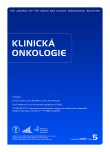Treatment Results in Patients Treated from 1980 to 2004 for Wilms‘ Tumour in a Single Centre
Authors:
J. Mališ 1; J. Radvanská 1; K. Slabý 2; T. Eckschlager 1; M. Procházka 2; B. Malinová 1; K. Pýcha 3; D. Kodetová 4; J. Radvanský 2
Authors‘ workplace:
Klinika dětské hematologie a onkologie 2. LF UK a FN Motol, Praha
1; Klinika rehabilitace a tělovýchovného lékařství 2. LF UK a FN Motol, Praha
2; Klinika dětské chirurgie 2. LF UK a FN Motol, Praha
3; Ústav patologické anatomie a molekulární medicíny 2. LF UK a FN Motol, Praha
4
Published in:
Klin Onkol 2010; 23(5): 332-342
Category:
Original Articles
Overview
Backgrounds:
The principle behind the treatment of nephroblastoma has been similar for at least 4 decades, based on vincristine and dactinomycine, radiotherapy in selected stages. The last three decades have been characterised by the aim to reduce the intensity and length of treatment.
Design:
To retrospectively compare survival rates and treatment success in a cohort of patients aged under 19 years, treated from 1980 to 2004 at a single centre by five consecutive treatment protocols.
Materials and Methods:
The outcome was evaluated in patients treated consecutively by two protocols established at the centre before 1980 and modified in 1986, and from 1988 consecutively by three accepted protocols, SIOP9, SIOP93 and SIOP2001.
Results:
Overall survival as well as event‑free survival rates were evaluated by Kaplan ‑ Meier functions in 315 patients (52.7% women). The average age at diagnosis was 3.9 ± 2.9 years, median 3.3, range 0.01 – 17.2 years. Age over 12 years in 2.2% patients. The average follow‑up time was 13.1 ± 7.8, median 13.6, range 0.2 – 27.8 years. The original 104 weeks of protocol KDO86 treatment had a 10‑year overall survival rate of 91.9 ± 3.2%. Overall survival significantly fell with radiotherapy reduction in lower clinical stages and treatment diversification in protocols with substantial treatment length reduction. Overall survival returned to the original value of KDO86 only in 1994, when SIOP93 was accepted with a 10‑year overall survival rate of 92.47 ± 3.0% and event‑free survival 85%, with similar trends in the latest protocol, SIOP2001. In the entire cohort two coincident malignancies (tumour duplicities) were found: one B‑lymphoma, one neuroblastoma. A second malignancy occurred in one patient – superficial spreading melanoma.
Conclusion:
from the retrospective view the accepted SIOP9 protocol has a significantly worse outcome in both the overall survival and in event‑free survival rate compared with the original therapy. Only the SIOP93 and SIOP2001 protocols accepted after 2003 have an acceptable 10‑year overall survival rate (around 92%) as well as event‑free survival (85%) with substantially reduced length and intensity of treatment, lowering the risk of late effects.
Key words:
nephroblastoma – survival – treatment protocols
Sources
1. Kalapurakal JA, Dome JS, Perlman EJ et al. Management of Wilms‘ tumour: current practice and future goals. Lancet Oncol 2004; 5(1): 37 – 46.
2. Metzger ML, Dome JS. Current Therapy for Wilms’ Tumor. The Oncologist 2005; 10(6): 815 – 826.
3. D’Angio JG. Pre ‑ or Postoperative Therapy for Wilms’ Tumor? J Clin Oncol 2008; 26(25): 4055 – 4057.
4. Vujanić GM, Kelsey A, Mitchell C et al. The role of biopsy in the diagnosis of renal tumors of childhood: Results of the UKCCSG Wilms tumor study 3. Med Pediatr Oncol 2003; 40(1): 18 – 22.
5. Breslow NE, Ou SS, Beckwith JB et al. Doxorubicin for favorable histology, Stage II – III Wilms tumor: results from the National Wilms Tumor Studies. Cancer 2004; 101(5): 1072 – 1080.
6. Kaste SC, Dome JS, Babyn PS et al. Wilms tumour. prognostic factors, staging, therapy and late effects. Pediatr Radiol 2008; 38(1): 2 – 17.
7. Radvanský J, Radvanská J, Slabý K et al. Pozdní následky Wilmsova tumoru a jeho léčby u pacientů léčených v letech 1980 – 2001 na jediném pracovišti. Klin Onkol 2010; 23(4): 245 – 255.
8. Radvanská J, Slabý K, Hladíková M et al. Léčebný úspěch onkologické léčby pacientů v dlouhodobé remisi Hodgkinovy choroby léčených v letech 1980 – 1999 na klinice dětské onkologie. Klin Onkol 2004; 17(2): 51 – 56.
9. Carli M, Fanscella E, Tournande MF et al. Second malignant neoplasms in patients treated on SIOP Wilms tumour studies and trials 1, 2, 5, and 6. Med Pediatr Oncol 1997; 29(8): 239 – 244.
10. Gatta G, Capocaccia R, Coleman MP et al. Childhood cancer Survival in Europe and the United States. Cancer 2002; 95(8): 1767 – 1772.
11. Weirich A, Ludwig R, Graf N et al. Survival in nephroblastoma treated according to the trial and study SIOP ‑ 9/ GPOH with respect to relapse and morbidity. Ann Oncol 2004; 15(5): 808 – 820.
12. SEER: Surveillance, Epidemiology and End Results. SEER Pediatric Monograph. Cancer Incidence and Survival among Children and Adolescents: United States SEER Program 1975 – 1995. National Cancer Institute 2004. [http:/ / seer.cancer.gov/ publications/ childhood].
13. De Kraker J, Graf N, Van Tinteren H et al. Reduction of postoperative chemotherapy in children with stage I intermediate ‑ risk and anaplastic Wilms‘ tumour (SIOP93 – 01 trial): a randomised controlled trial. Lancet 2004; 364(6): 1229 – 1235.
Labels
Paediatric clinical oncology Surgery Clinical oncologyArticle was published in
Clinical Oncology

2010 Issue 5
- Metamizole vs. Tramadol in Postoperative Analgesia
- Metamizole at a Glance and in Practice – Effective Non-Opioid Analgesic for All Ages
- Possibilities of Using Metamizole in the Treatment of Acute Primary Headaches
- Metamizole in perioperative treatment in children under 14 years – results of a questionnaire survey from practice
- Obstacle Called Vasospasm: Which Solution Is Most Effective in Microsurgery and How to Pharmacologically Assist It?
Most read in this issue
- Diagnostic Pitfalls of HIV‑ Associated Kaposi Sarcoma
- Hand‑ Foot Syndrome after Administration of Tyrosinkinase Inhibitors
- Mucoepidermoid Carcinoma of a Nasal Cavity – a Rare Tumour
- 18F‑ FDG PET/ CT and 99mTc‑ MIBI Scintigraphy in Evaluation of Patients with Multiple Myeloma and Monoclonal Gammopathy of Unknown Significance: Comparison of Methods
